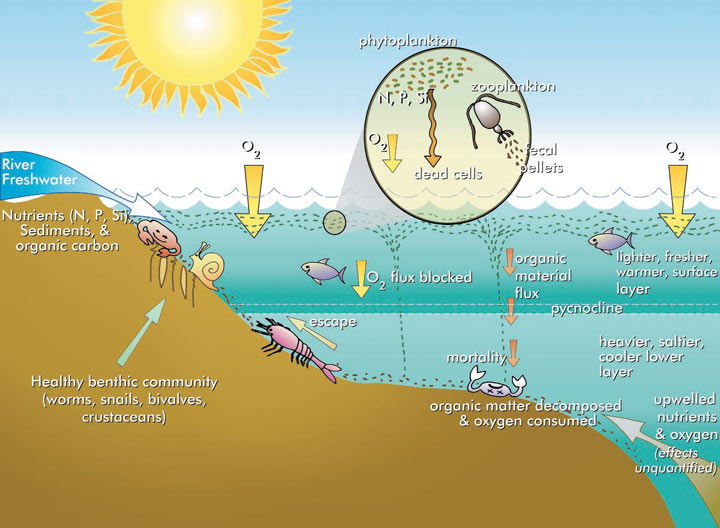What is hypoxia?
Hypoxia, or oxygen depletion, is an environmental phenomenon where the concentration of dissolved oxygen in the water column decreases to a level that can no longer support living aquatic organisms, such as fish, crabs, and shrimp.
Hypoxia in the northern Gulf of Mexico is defined as a concentration of dissolved oxygen less than 2 mg/L (2 ppm). This figure is based on observational data that fish and shrimp normally present on the sea floor are not captured in bottom-dragging trawls at oxygen levels < 2 mg/L. In other oceans of the world, the upper limit for hypoxia may be as high as 3-5 mg/L. While these low oxygen areas are often called “Dead Zones,” and larger organisms flee the area or die, not all is ‘dead.’ Some bacteria thrive in these zones, and there are many swimming organisms in the upper water column.
Hypoxia occurs naturally in many of the world’s marine environments, such as fjords, deep basins, open ocean oxygen minimum zones, and oxygen minimum zones associated with western boundary upwelling systems. Hypoxic and anoxic (no oxygen) waters have existed throughout geologic time, but their occurrence in shallow coastal and estuarine areas appears to be increasing as a result of human activities. The largest human-caused hypoxic zone currently affecting the United States, and the second largest coastal hypoxic zone worldwide, occurs in the northern Gulf of Mexico adjacent to the Mississippi River on the Louisiana/Texas continental shelf. The maximum areal extent of this hypoxic zone was measured at 22,000 km² during the summer of 2002; this is approximately the same size as the state of Massachusetts.
The average size of the hypoxic zone in the northern Gulf of Mexico over the past 30 years (1985-2014) is about 13,650 square kilometers (or 5,300 square miles). For comparison, the entire surface area of the Chesapeake Bay and its major tributaries measures about 11,000 square kilometers.
What causes hypoxia?
An animation of the flows along the rivers of the Mississippi watershed. This animation does not show actual flow rates of the rivers. All rivers are shown with identical rates. The river colors and widths correspond to the relative lengths of river segments.
Source: NASA’s Scientific Visualization Studio via Horace Mitchell (NASA/GSFC)
Major events leading to the formation of hypoxia in the Gulf of Mexico include:
-
- 1. Freshwater discharge and nutrient loading of the Mississippi River
-
- 2. Nutrient-enhanced primary production
-
- 3. Decomposition of biomass by bacteria on the ocean floor, which uses up oxygen
-
- 4. No resupply of oxygen due to stratification, layering of water masses
The Mississippi River basin drains approximately 41% of the land area of the conterminous United States, ranging as far west as Idaho, north into Canada, and east into New York State.
The Mississippi River system is the dominant source of fresh water and nutrients to the northern Gulf of Mexico. The discharge of the Mississippi River system is controlled so that 30% flows seaward through the Atchafalaya River delta and 70% flows through the Mississippi River birdfoot delta. About 53% of the Mississippi River delta discharge flows westward onto the Louisiana shelf.
Mississippi River nutrient concentrations and loading to the adjacent continental shelf have changed greatly in the last half of the 20th century. During this time there has been a marked increase in the concentration of nitrogen and phosphorus in the Lower Mississippi River. This increase has been attributed to the increased use of nitrogen and phosphorus fertilizers, nitrogen fixation by leguminous crops, and atmospheric deposition of oxidized nitrogen from the combustion of fossil fuels. Nitrogen and phosphorus occur in four inorganic forms in the river: nitrate (NO3−), nitrite (NO2−), ammonium (NH4⁺), and orthophosphate (PO4³⁻). Many of these nutrients enter the river from non-point sources like runoff, which are much more difficult and complex to control and monitor than point sources of pollution.
Eutrophication initiates a massive growth of phytoplankton on the water’s surface. Eutrophication follows when ocean systems are over enriched with nutrients beyond natural levels, causing significant increases in primary production, or growth of algae in marine systems. In the same way that nitrogen and phosphorus fertilize human crops, they also fertilize plants in the ocean. The spring delivery of nutrients initiates a seasonal progression of biological processes that ultimately leads to the depletion of oxygen in the bottom water.
In the northern Gulf of Mexico, high concentrations of nutrients stimulate a massive growth of phytoplankton on the water’s surface. Much of this phytoplankton is consumed by zooplankton and eventually the fish food web. The size of the phytoplankton population is well beyond the natural capacity of predators or consumers to graze it down to a balanced level. Fecal pellets resulting from zooplankton feeding sink to the lower water column and seabed. Phytoplankton not consumed by predators eventually die and also sink to the bottom waters where they await decomposition by bacteria. Aggregates of phytoplankton cells, fecal pellets, and other detritus also contribute to the organic loading to the bottom.
During much of the year, the water column is stratified, meaning that temperature and salinity are not uniform from top to bottom. Fresh water flowing from the river, and seasonally warmed surface water in spring through fall, is less dense and forms a layer above the saltier, cooler and more dense water masses near the bottom. This stratification leaves the bottom layer isolated from the surface layer and cut off from a normal resupply of oxygen from the atmosphere.
Nutrient-based Hypoxia Formation:
1) Nutrient-rich fresh water flows into the coastal Gulf of Mexico
2) Algae photosynthesize, fix carbon, and support the coastal ocean food web; some may die and sink to the bottom as cells or in aggregates
3) Zooplankton consume the algae
4) Bacteria decompose fecal pellets and dead algae in the lower water column
5) Bacteria deplete the water of oxygen
6) Marine life flees or dies
As bacteria on the ocean floor decompose the abundant carbon in the phytoplankton that sinks down, oxygen is consumed. Because of water column stratification, oxygen consumption rates at the bottom of the ocean easily exceed those of resupply and the result is hypoxia, or low dissolved oxygen. Organisms capable of swimming (i.e., fish, shrimp, and crabs) evacuate the area, but less motile fauna experience stress or die as a result of low oxygen. Hypoxia has the potential to damage important natural resources in the Gulf of Mexico over the long term as food webs become disrupted and organisms at all trophic levels are impacted, including fisheries.
Hypoxia can persist several months until there is strong mixing of the coastal waters, which can come from tropical storms or hurricanes and thermal turnover or cold fronts in the fall and winter.
History of Hypoxia Research in the Northern Gulf of Mexico
Hypoxia was first documented in the northern Gulf of Mexico off the Louisiana coast in 1972. Sporadic occurrences were observed in subsequent years. In 1975 and 1976, two cruises were conducted specifically to map a suspected area of low oxygen along the Louisiana coast. These maps indicated small, disjunct areas of hypoxia. With an increase in oceanographic research in the Gulf of Mexico, more reports of hypoxia emerged. The first concerted, continuous, and consistent documentation of the temporal and spatial extent of hypoxia on the Louisiana and Texas continental shelf began in 1985 with funding from the National Oceanic and Atmospheric Administration, National Ocean Service. Dr. Don Boesch, then Director of Louisiana Universities Marine Consortium (LUMCON), initiated the study, which was led by Dr. Nancy N. Rabalais of LUMCON and Drs. R. Eugene Turner and William J. Wiseman, Jr. of Louisiana State University. Drs. Dubravko Justic (modeling) and Quay Dortch (phytoplankton ecology) joined the team in the late 1980s.
Over the next 38 years from research initiation, the research group expanded their studies, included more components and collaborators, and began unraveling the dynamics of hypoxia in this river-dominated coastal ecosystem. For more information, and to read about current research efforts, please visit the Research and Resources sections of our website.
The research group is in transition, but with the same focus on the land-ocean interactions of the Mississippi River and coastal ocean of the northern Gulf of Mexico. Dr. Cassandra Glaspie (Louisiana State University) will start taking over as the Principal Investigator in 2023 with Dr. Nancy Rabalais (now at Louisiana State University) becoming the co-Principal Investigator.




